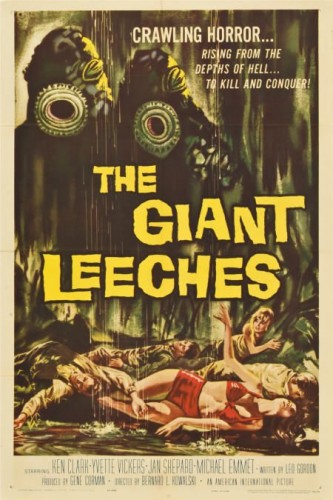
Thanks again for your patience with us this past week. As you’ll see, while the site slept, some of us were busy!
Episode 84: Yvette Vickers (f. 4.27.11)
Newspapers and blogs seem to settle for the categorical in reporting such events as the discovery, on April 27, 2011, of the body of Yvette Vickers in her house in Benedict Canyon.
 Yvette Vickers’s death becomes a “bizarre” event, and gets linked to the Gothic, even, as it applies to the kinds of movies in which she appeared. (She gave knockout performances, by the way, in her two “legacy” films: Attack of the 50 Foot Woman and Attack of the Giant Leeches.) No one who has seen these films will ever forget them, and for a whole bunch of reasons.
Yvette Vickers’s death becomes a “bizarre” event, and gets linked to the Gothic, even, as it applies to the kinds of movies in which she appeared. (She gave knockout performances, by the way, in her two “legacy” films: Attack of the 50 Foot Woman and Attack of the Giant Leeches.) No one who has seen these films will ever forget them, and for a whole bunch of reasons.
Nevertheless, the “mummified remains” of Yvette Vickers were found in her Benedict Canyon home on April 27, 2011. You might as well, judging from the photographs of her house, outside and inside, speak of the “mummified remains” of her life.
I think we need to talk about Yvette Vickers, and “What is and what should never be” (Led Zeppelin). What happened can’t just be dismissed, or relegated to the category of swiftly passing sensational events. Moreover, your heart has to go out to her.
When you see videos of Yvette Vickers in recent times, hawking 8″x 10″ stills of herself from much earlier times, at fantasy and horror film conventions, your heart just has to go out to her. The contrast between then and now is simply too great.
This podcast is an attempt, I hope a pastoral attempt, to understand her extraordinary loss and death, and to draw from it something that might be reconciling for us, to “we the living”.
Helas!: one is so seldom given the chance to be there, when, as Aldous Huxley called it, the decisive moment comes.
Episode 85: Protestant Episcopalians in SuperMarionation
Episcopal haberdashery in movies and television is an interesting subject. Or let’s put it this way: the way Hollywood has garbed Episcopal bishops and ministers constitutes a delightful portrait of changing fashion.
Thus, Episcopal ministers in the movies are almost always garbed in Protestant or “Low Church” robes until the 1970’s. In any event, after the Seventies fewer and fewer Episcopal clergy are depicted in Hollywood movies, partly because clergy begin to be portrayed as unctuous hypocrites, sometimes downright criminals. No more David Niven bishops after that period of our cultural life.
 But here I’m talking about classic movies such as “It Happened One Night”, in which the rector is perfectly attired for the wonderfully interrupted wedding of Claudette Colbert (not) to Clark Gable. Or the first Disney version of “The Parent Trap”, in which Leo G. Carroll is also perfectly attired in the role. (Did you know that there are four Disney versions of this movie, the second of which — not the Lindsey Lohan version — constitutes a perfect case in point of this point?)
But here I’m talking about classic movies such as “It Happened One Night”, in which the rector is perfectly attired for the wonderfully interrupted wedding of Claudette Colbert (not) to Clark Gable. Or the first Disney version of “The Parent Trap”, in which Leo G. Carroll is also perfectly attired in the role. (Did you know that there are four Disney versions of this movie, the second of which — not the Lindsey Lohan version — constitutes a perfect case in point of this point?)
Then we come to Sylvia and Gerry Anderson’s amazing exercise in early SuperMarionation that was called “Secret Service”. It was produced in 1968 and ’69 in England, and is, in its close haberdashery, pure “Protestant Anglicanism”, notwithstanding “Father” Unwin. (Here you have to know that ‘Padre’ is an outward and visible sign of an inward and spiritual “Low Church” understanding on the part of non-churchgoing Anglicans. ‘Padre’ is a dear and wonderful term.) Almost every episode of “Secret Service” concludes with the vicar preaching in pure Protestant visuals. (Love that show!)
It is vital that you listen to this podcast, for the sake of your Eternal Soul.
Episode 86: SuperMarionation II
I think there may be something else here: “What Lies Beneath”. I think a survey of Protestant Episcopal ministers in Hollywood movies, not to mention SuperMarionation, can take us somewhere else. It lands us in the neighborhood of social class.
We can wish it didn’t. We can chalk it up to Frank Capra, and just consider it to be a question of unoffending benign fuddy-duddies. But I fear it’s more than that.
We’re probably getting a little close, via Tinseltown, to the core reason for mainstream decline in our churches. Just think of that basement cemetery in “Arsenic and Old Lace”, the graveyard of sweet visiting Protestant ministers. Maybe Hollywood can teach us as much as any survey.
We end, however, with hope — on a great note of Liberal Low Church hope: Hymn 263 (1940 Hymnal), “In Christ there is no East or West”.
[youtube=http://www.youtube.com/watch?v=xAsE-89wNWQ&w=600]
The painted portraits of Huguenot leaders of the Sixteenth Century, theological, literary, political, and military, all have one feature in common. It’s the eyes! Whether it’s Clement Marot, the poet; Duplessis-Mornay, the political philosopher; Theodore de Beze, the theologian and churchman; Henri de Rohan, the soldier; Gaspard de Coligny, the tragic grand fromage himself; or Agrippa d’Aubigne, that ‘Nathan Bedford Forrest’ of the French Wars of Religion: they have these piercing defeated eyes.
You can read defeat plainly in the eyes of every one of these great men — DEFEAT, which is to say violent death, or just exile (plus, exile, exile again, and then again, exile). I think we can learn something from the eyes.
 The ego needs defeat. As Kerouac said: “No other way”. Only from some kind of non-self-referential ego-lessness is lasting service possible. If the ego is not defeated, you’re always asking — or rather, your ego is always asking — what’s in this situation (or in this person) for me?
The ego needs defeat. As Kerouac said: “No other way”. Only from some kind of non-self-referential ego-lessness is lasting service possible. If the ego is not defeated, you’re always asking — or rather, your ego is always asking — what’s in this situation (or in this person) for me?
That question, like ego-life in its entirety, is for the birds. The eyes have it.
I’ve come to think, with Kerouac, that “‘facts’ are sophistries”. Expressed another way, reality is not what it appears.
This becomes concrete when you study Egyptian mummy movies of the 1940’s. One of them — probably all of them — tells a tale which packs more emotional truth, within its one hour and one minute, than any number of other reports concerning life on this planet. That movie is “The Mummy’s Ghost” (1944), starring Lon Chaney, Jr.. It is a kind of wonder.
In this cast, I apply the reality of “Ghost”, as we might call it, to the supposed reality of the “Arab Spring”, as commenced on Tahrir Square in Cairo. For me, the big item in all the news was not the hundreds of thousands of protesters, but rather, the theft of two mummies from the Cairo Museum, which just happens to sit on Tahrir Square. That was the item that got missed. That was the item that had reality.
The Cross is humanity’s great symbol, of repentance and forgiveness. It speaks to one of two, enormous human needs.
There is a second, perhaps also secondary, need, which is to understand the nature of Reality, given the veils, screens, and projections we impose upon it. This is where Egyptian mummy movies can help us.
I’m serious.
One is so accustomed to being a lone wolf in relation to predator drones — especially in one’s faith community — that I’ve given up. (Gave up six months ago, to be precise.)
 But some recent comments by Steven Spielberg, concerning a treasured old movie (i.e., “The Space Children”), made me get sympathetic… to myself!
But some recent comments by Steven Spielberg, concerning a treasured old movie (i.e., “The Space Children”), made me get sympathetic… to myself!
That precious little movie explained to me my handicap. It is a handicap because I feel disabled — unable to connect with the thought-world of something like 99.9 % of my fellow citizens, who believe that predator drones are a good thing: costless technology to remove the bad guys.
I failed completely in a very minor campaign to raise awareness on the immorality of drones. It turned out to be “something about me, baby” (The Four Tops), not about anybody else. I’d simply been missing something.
Then Steven Spielberg, who was talking about a forgotten movie and not about drones — I repeat, not about drones — conveyed a possibility, a rare and unevoked personal possibility:
I learned that my handicap had a cause, and a few (very young but now very old) friends. Seven, to be exact. Now I know what’s wrong with me; and, as the saying goes, I’d rather know than live with the uncertainty of not knowing.
[youtube=http://www.youtube.com/watch?v=iL1qjde3ZWo&w=600]

COMMENTS













